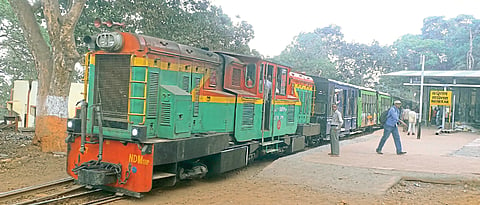

Matheran, tucked away in the Sahyadri hills, situated mid-way between Mumbai and Pune, is a quaint hill station. It is one of the few places on earth where no vehicles of any sort, save for a lone ambulance, are allowed. This makes Matheran’s air pollution-free, conducive to longevity. The town, with an area of seven square kilometres, abounds in bird and animal life. However, for a region so heavily wooded, it is surprising that there is scant wild life in Matheran. Leopards exist in the Sanjay Gandhi National Park to Matheran’s west, and in Junnar to its east. But no wild animal has been spotted in Matheran for a long time.
Matheran’s monkeys are legion. It is common to see monkeys snatch food from the hands of unsuspecting visitors. They enter hotel rooms on the sly and rummage the bags of tourists for wafers and biscuits. One ingenious pair that couldn’t squeeze through the window bars of a hotel room, sent their young ones through the bars to scrounge for food. The babies returned with packets of nuts and chips on which the family feasted.
Horses are Matheran’s lifeline, besides hand-pulled rickshaws. They selflessly ferry visitors all over town and to the various peaks, although their owners overwork them. But the owners cannot be blamed because Matheran’s economy is fuelled mainly by tourism.
A friend who runs a hotel in Matheran tells us that out of 365 days, hotels do business for just 100 days. For the rest of the year, their rooms are boarded up. And this is the plight of all hotels, big and small. There is an obvious reason for Matheran’s relative unpopularity compared to Mahabaleshwar, Maharashtra’s other star hill station: the absence of vehicles. Today’s youngsters will not venture out to places where they cannot drive their cars and bikes, or hire Uber and Ola cabs, literally up to their doorstep. In such a scenario, Matheran, which demands long treks through its dirt roads, or bumpy rides on horseback or hand-pulled rickshaws, is hardly on anyone’s wish list.
The Indian Railways too have accorded step-motherly treatment to Matheran. Its toy train that plies between Neral and Matheran, started way back in 1905, has not been given heritage status, unlike the Kalka-Simla toy train. It suffered colossal damage after the torrential rains of July 26, 2005, and has never fully recovered since. Today, the railways run a skeleton service between Neral and Matheran. But the train is so slow that it takes nearly three hours to reach its destination. Most people prefer to travel by taxi that covers the distance in 20 minutes.
Nor have the railways done anything to enhance the tourist value of the train, such as getting it hauled by a steam engine or introducing Vistadome coaches that provide a panoramic view of the landscape. The toy train remains suspended during the monsoon, from mid June to the end of October.
A decade ago, there used to be a cute little restaurant on the main platform of Matheran station, where passengers saw toy trains chugging in and out as they ate their food. Today, only ruins of the restaurant remain.
Though many hotels in Matheran are wi-fi enabled and mobile network connectivity has improved over the years, there are still areas in the town where phones don’t work. This displeases a generation hooked to social media.
Matheran has schools, including the English medium St. Xavier’s school run by missionaries. But the schools aren’t like Panchgani’s elite boarding schools. Their standard is poor. They stay open during the summer and are closed in the monsoon due to heavy rain.
Each summer Matheran’s civic administration sponsors a horse-racing event at its race course, known as the Olympia Race Course. This isn’t like the horse races of Mumbai and Pune where betting is big business. But it gives local horse-riders and jockeys a chance to display their skills. Some of the races, like the musical chairs race and the vegetable race are truly innovative. Imagine playing musical chairs on horseback! Yet, compared to earlier days, participation in the race is shamefully low. It seems as if the event is held merely out of formality.
Since Matheran has been declared eco-sensitive by the government, the builders’ lobby has little scope of infiltration into the hill station to build holiday homes for the rich. Thus, Matheran is spared the miserable fate of Khandala and Lonavala. However, old colonial bungalows built by the British dot the landscape. Many of them are in a state of disrepair and are even believed to be haunted. Some of these properties have been converted into hotels. Others, abandoned by their owners, are inhabited by Adivasi tribals and their families, who serve as caretakers.
Finally, Matheran has its literary side. The playwright Girish Karnad (who passed away on Monday) was born in Matheran. A British writer, Gary Richardson, has written a novel titled The Mad Horses of Matheran, set in the hill station. And a contemporary Indian writer, Siddharth Dhanvant Shangvi, once wrote an article in a magazine, in which he said that he had bought a house in Matheran, and had migrated from Bombay to live there.
If only more of us could be inspired by the example of these writers!
